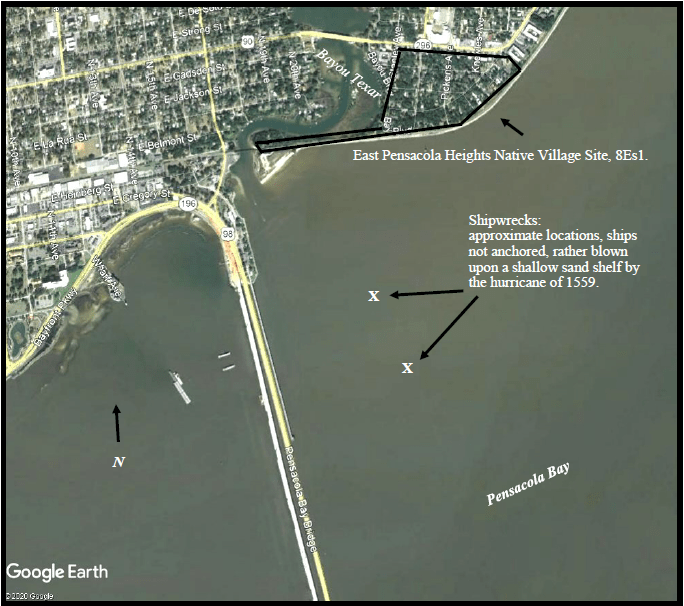The 1559 Luna Colony: Two Hypotheses
by Caleb Curren
Contact Archeology Inc.
by: Caleb Curren
July 2020
The Spanish Expedition led by Tristan de Luna in 1559 landed somewhere on Pensacola Bay. In 2015 the University of West Florida (UWF) claimed that they had found the colony site at the East Pensacola Heights Site (8Es1). UWF did not propose hypotheses based on empirical data, rather, they hastily stated that the colony site was definitely located at 8Es1. UWF has yet to publish a complete technical report of their excavations. Contact Archeology Inc. is now proposing two hypotheses relative to site 8Es1.

Hypothesis #1: The East Pensacola Heights Site (8Es1) is the location of the Luna Colony.
Positive Evidence: Numerous 16th-Century Spanish artifacts have been found on the site.
Negative Evidence: Numerous Spanish burials, structures, refuse pits, and firehearths have not been found although Native burials have been found by local people. The Smithsonian Institution in 1883 also reported two burial mounds on the site. The 16th-Century shipwrecks off the shore of the site were wrecked on a shallow sand shelf and were not anchored. The shipwrecks could have been blown onto the sand shelf from anywhere in the bay during the hurricane of the summer of 1559.
Hypothesis #2: The East Pensacola Heights Site (8Es1) is a Native village or seasonal campsite from which Native people salvaged the shipwrecks just offshore and/or the Luna Colony located in another area of Pensacola Bay.
Positive Evidence: The 16th-Century Spanish artifacts found by UWF were mixed with Native artifacts. Numerous Spanish burials, structures, refuse pits, and firehearths have not been found. The anchorage of the Luna fleet has not been found.
Negative Evidence: There is none.
Tests for the two hypotheses:
Hypotheses #1: Continue to excavate the East Pensacola Heights Site in hopes of finding the requisite archeological features necessary to prove the presence of the Luna Colony site.
Hypotheses #2: UWF needs to produce a detailed technical report of their excavations at the site. By providing this data, peer reviews can then determine conclusions based on the data. Also, there needs to be underwater surveys of portions of Pensacola Bay to search for numerous anchors associated with the anchorage of the ships of the Luna Colony. By finding the anchorage, the colony should be close by.

- Article
-
by: Caleb Curren
July 2020The Spanish Expedition led by Tristan de Luna in 1559 landed somewhere on Pensacola Bay. In 2015 the University of West Florida (UWF) claimed that they had found the colony site at the East Pensacola Heights Site (8Es1). UWF did not propose hypotheses based on empirical data, rather, they hastily stated that the colony site was definitely located at 8Es1. UWF has yet to publish a complete technical report of their excavations. Contact Archeology Inc. is now proposing two hypotheses relative to site 8Es1.

Hypothesis #1: The East Pensacola Heights Site (8Es1) is the location of the Luna Colony.
Positive Evidence: Numerous 16th-Century Spanish artifacts have been found on the site.
Negative Evidence: Numerous Spanish burials, structures, refuse pits, and firehearths have not been found although Native burials have been found by local people. The Smithsonian Institution in 1883 also reported two burial mounds on the site. The 16th-Century shipwrecks off the shore of the site were wrecked on a shallow sand shelf and were not anchored. The shipwrecks could have been blown onto the sand shelf from anywhere in the bay during the hurricane of the summer of 1559.Hypothesis #2: The East Pensacola Heights Site (8Es1) is a Native village or seasonal campsite from which Native people salvaged the shipwrecks just offshore and/or the Luna Colony located in another area of Pensacola Bay.
Positive Evidence: The 16th-Century Spanish artifacts found by UWF were mixed with Native artifacts. Numerous Spanish burials, structures, refuse pits, and firehearths have not been found. The anchorage of the Luna fleet has not been found.
Negative Evidence: There is none.Tests for the two hypotheses:
Hypotheses #1: Continue to excavate the East Pensacola Heights Site in hopes of finding the requisite archeological features necessary to prove the presence of the Luna Colony site.Hypotheses #2: UWF needs to produce a detailed technical report of their excavations at the site. By providing this data, peer reviews can then determine conclusions based on the data. Also, there needs to be underwater surveys of portions of Pensacola Bay to search for numerous anchors associated with the anchorage of the ships of the Luna Colony. By finding the anchorage, the colony should be close by.

- Download PDF Version